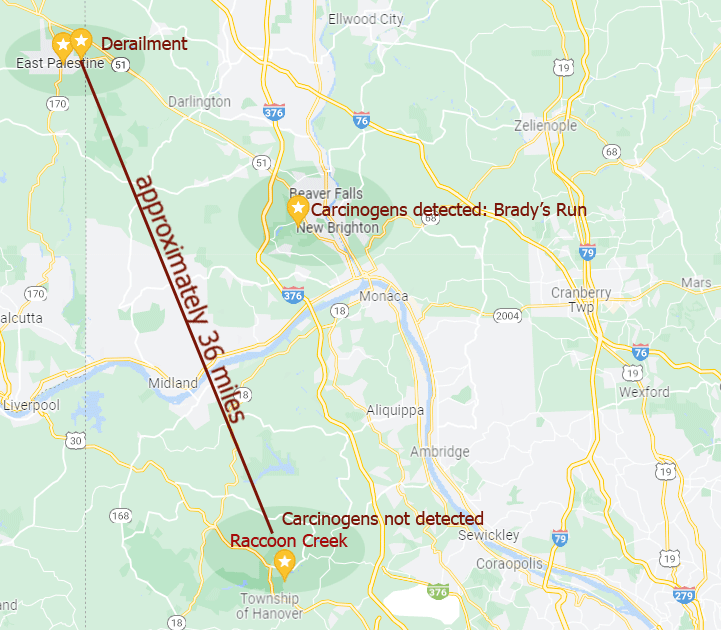Carcinogens[1] have been found in the water in near East Palestine, Ohio, where a train derailment took place last month, Feb. 3. A total of 38 rail cars derailed, some of which were carrying “several hazardous chemical compounds, documents from the railway company show — including the residue of one that is known for its link to genetic mutations.”[2]
Justin Johnston of Pittsburgh-based Big Pine Consultants[5] has been on the ground since the early days following the derailment. Big Pine Consultants (“BPC”) “completed water quality sampling of nine stream sites “downstream” and “downwind” of the derailment in East Palestine, Ohio on February 17, 2023.” BPC received the analytical results of laboratory tests March 3, 2023 and published a drafted report of the findings,[6] which found six “probable carcinogens” that the Ohio EPA didn’t detect.
This independent sampling is being completed and self-funded by [BPC] only. There is no funding or sampling being provided by any government agency or other company related to this effort. [BPC] is not part of the government or Norfolk Southern response team and is also not being retained by any outside 3rd parties seeking legal remedies against Norfolk Southern.[5]
BPC Findings: Summary
BPC data show soil in the Ohio town of East Palestine – scene of a recent catastrophic train crash and chemical spill – contains dioxin levels hundreds of times greater than the exposure threshold above which Environmental Protection Agency (EPA) scientists in 2010 found poses cancer risks.
The levels found in two soil samples are also up to 14 times higher than dioxin soil limits in some states, and the numbers point to wider contamination, said Linda Birnbaum, a former head of the US National Toxicology Program and EPA scientist.[3]
Additional Key Takeaways of BPC Findings
- Downwind, there are low but detectable levels of several probable carcinogens in the surface water that are mainly formed by incomplete combustion of organic compounds. Four such probable carcinogens were present above “Report Limits” in at least one sample including Benzo(b)fluoranthene, Benzo(k)fluoranthene, Dibenzo(a,h)anthracene, and Indeno(1,2,3-cd)pyrene. Two additional probable carcinogens were present: Benzo(a)pyrene and Bis(2-ethylhexyl)phthalate. Benzo(b)fluoranthene was the most prominent as it was above the Report Limit in four samples.
- There is no safe level of exposure to carcinogens. Their presence is a danger to long term health.
- Ohio EPA is not finding these because their methods are not sensitive enough to find these compounds.
- We cannot directly confirm or deny with certainty that these are from the controlled burn, however the results do support that they are from the controlled burn.
- State and federal agencies testing surface and groundwater should evaluate their sampling and analytical methods to make sure they are using the appropriate sensitivity to find these compounds.
- The carcinogens were detected as far away as South Branch Brady Run, at Brady’s Run Park. They may have travelled further, but were not detected in Raccoon Creek.



The message from the Ohio EPA was somewhat less alarming. They shared the results of their own air and water testing, and stated on their official web site[7] that:
- As of right now, there is no indication of risk to East Palestine Public Water customers. Treated drinking water shows no detection of contaminants associated with the derailment.
- A containment area was created on February 8. Clean water from upstream is being pumped around the containment area to isolate any grossly contaminated water and sediment. This minimizes the amount of contaminants that could flow downstream. Contractors are working to remove the contaminated water in the containment area.
- The week of February 6, the Columbiana County Health District collected their own samples of water to be tested. The results were consistent with the contractor’s results, both showing no contaminants associated with the derailment.[7]
The EPA did indicate that the water in Sulphur Run near the derailment site was “grossly contaminated.” This is not surprising, given its proximity to the accident.

Notes and Sources
[1] https://www.cancer.gov/about-cancer/causes-prevention/risk/substances/carcinogens
[2] https://www.cbsnews.com/news/what-is-vinyl-chloride-what-other-chemicals-were-on-train-derailed-east-palestine-ohio/
[3] https://www.theguardian.com/us-news/2023/mar/17/norfolk-southern-derailment-east-palestine-ohio-carcinogenic-chemical-levels
[4] https://www.in.gov/idem/files/report_10644640_SW8290FC_L4_R1_dfr.pdf
[5] https://bigpineconsultants.com/east-palestine-train-derailment-water-quality/
[6] https://bigpineconsultants.com/east-palestine-water-quality-full-report/ Original source
[7] https://epa.ohio.gov/monitor-pollution/pollution-issues/east-palestine: This page was archived several times, including on March 17, 2023 here. In case live content on the site is modified by the Ohio EPA and content no longer match what is cited above, refer to this archive link for historical accuracy.